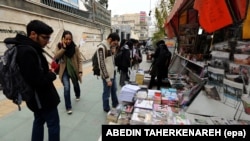Declining readership and increased printing costs are hitting Iran’s newspapers hard, with two publications shutting down in the last month.
The reformist daily Hambastegi (Solidarity), which is affiliated with the political party of the same name, and the conservative daily Sobh-e No (The New Morning), linked to former Tehran Mayor Mohammad Baqer Qalibaf, are the latest newspapers to cease publication.
Both reformist and conservative-leaning papers have suffered dips in circulation in recent years, and nearly all of the country’s dailies have raised their prices in an attempt to off-set costs, especially the high price of printing paper.
Culture Ministry estimates from 2012 put the daily number of newspapers sold in Iran at over two million, compared to 800,000 sold according to November 2017 figures published in Mehr News Agency. Iran's most popular newspaper, Hamshahri, which sold over 500,000 copies per day in 2012, dropped to 180,000 in mid-August. During the same period, the circulation of Jam-e Jam, which is affiliated with Iranian state TV, dropped from around half a million to 70 to 80 thousand copies per day.
Based on the latest figures, most major newspapers publish under or around 7000 copies a day. These include Arman, Sharq, Etemad, Javan, Aftab-e Yazd, and Shahrvand.
The actual circulation of Iran’s dailies may be even lower, as the newspaper publishers report their own sales without independent verification, and they may exaggerate their popularity to maximize government subsidies given to newspapers on the basis of readership, according to columnist Abbas Abdi.
Some allege that newspapers loyal to hardliners within the government receive generous government subsidies despite their lack of popularity.
As a condition of receiving government subsidies, newspapers are required to maintain a web presence. Most Iranian newspapers publish pdf versions on the Internet hours before the hard copy version hits newsstands.
Recently some newspapers such as the centrist Sazandegi have dialed down their online presence in order to ensure maximum profitability at the news stands. Some others, such as the reformist daily Sharq, have instituted a paywall for their websites.
Meanwhile, the scarcity and high price of printing paper has forced many newspapers to reduce their page count from 24 or more to 16 or 12. The
government has added printing paper to the list of essential commodities and subsidized paper imports in an effort to support print titles.
At the same time, strict state control over newspaper content has made them less interesting for readers.
This comes while newspaper advertising revenues have dropped dramatically as Iran's economic crisis has worsened following the U.S. pull-out from the nuclear deal with Iran and renewed sanctions.
With state TV monopolized by regime hardliners and news agencies owned by the government, Iranian newspapers are the last platform outside of the web where diverse views can be expressed



